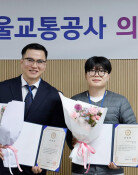No Energy-Wasting Buildings Allowed
No Energy-Wasting Buildings Allowed
Posted November. 16, 2005 08:23,
The Ministry of Construction and Transportation plans to draw up concrete measures by August next year before revision and enforcement of relevant laws starting in 2007 to include more buildings subject to its new plan. This action comes with a pressing need for energy conservation as high oil prices prolong and the United Nations Framework Convention on Climate Change (UNFCCC) to reduce greenhouse gases takes effect.
Low Energy Consumption Required for Approval-
Maximum energy consumption system only authorizes construction that meets a limited energy consumption per m² of a building, which is already being implemented in Japan, the U.K., and Germany.
The Korea Institute of Construction Technology (KICT) will build standard structures for each architecture purpose and design by August of next year and measure energy consumption per m², which will be set as a requirement for approval.
First of all, only public buildings such as large or government complexes with gross floor area over 10,000 m² will be subject to the new standard, but regular buildings and co-ops will also follow suit in the mid- to long-term.
Excluding the residential apartments, buildings comprising an area of 40 million to 50 million m² are built annually, said Geon Gi-yeon, an architecture research managing director at the KICT, and estimated, The large-scale buildings immediately subject to the maximum energy consumption system will be around five percent.
He plans to propose ways to expand the scope of structures required to submit energy conservation plans for construction approval, from the current eight types such as co-ops with more than 50 units to public buildings with a gross floor area of less than 1,000 m² (302.5 pyeong), passenger terminals, and railway station buildings.
Enhancing the Development of Energy-Saving Technology-
The maximum energy consumption system regulates a buildings total energy consumption unlike the energy-saving design standard that defines different criteria for each area, including outer walls, roofs, floors, electricity and heating facilities.
If the energy design standard is raised 10 percent from the current level, he estimates 3.5 trillion won in energy savings over a decade. This equals an annual conservation of 350 billion won.
Adoption of the system is also likely to boost the development of architecture applying the new technology, including renewable energy.
Kolon Constructions manager at the technology research center Kim Yong-gyeong predicted, Introducing the system will lead to development of new, diverse construction materials, techniques, and design.
Technology is There, Challenges to Commercialization-
The construction industry is also scrambling to develop architecture technologies that use less energy in order to adapt to high oil prices.
A good example is 3L House, which has been developed jointly by Daelim Industrial Co. with domestic and foreign companies.
This house, which will take place at the Daelim Industrial Training Center in Yongin, Gyeonggi Province next month, will use geothermal and solar energy for heating, hydrogen cells for electricity, and waste heat of hydrogen cell for heat pumps. In other words, it is similar to the concept of passive house, which is designed to minimize oil or electricity use.
It was named 3L House because it took only three liters of oil a year to heat or cool one m² of the two-story house with a gross floor area of 42 pyeong. This is merely one-sixth of the 17.7 liters spent for general-purpose housing in Korea.
One shortfall is high cost, however, which is why experts say government support is inevitable for widespread use of the public.
Constructing 3L House costs a total of 608.75 million won, including 250 million won for production and installation of hydrogen cells. The cost is more than threefold that of regular housing with similar scale.
We spent 1.3 billion won in developing energy-saving technology last year, but no government support was given for research on commercialization, said Park Sang-dong, the green building project manager with Korea Institute of Energy Research, and noted, Technological development is important, but what we need is the governments attention to commercialization.
imsoo@donga.com







